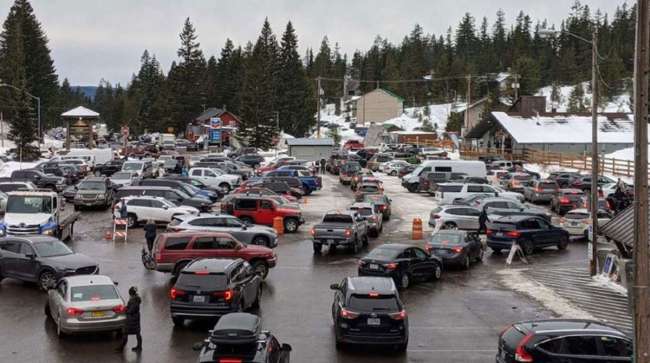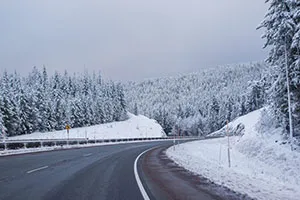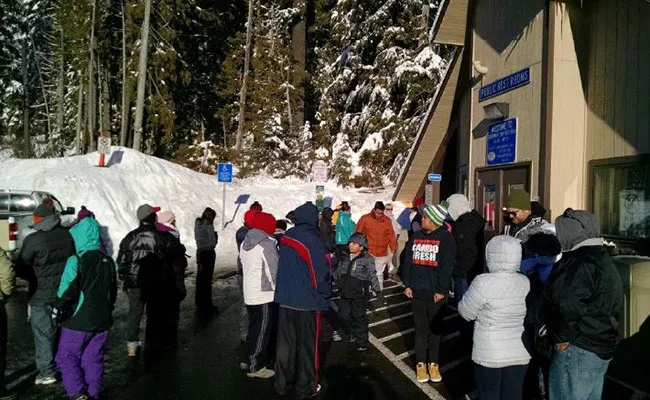Staff Reporter
Truck Parking Eyed in Planning for Rest Area Site in Oregon

[Stay on top of transportation news: Get TTNews in your inbox.]
Although it qualifies as a state rest area, a concrete latrine building next to 13 parking places atop Mount Hood is the only such public facility for truckers and others traveling on U.S. Route 26 for 145 miles between Portland and Bend in Oregon.
“There ought to be a place where people can pull off safely and get their needs met. Currently, the only real ‘facility’ between the two [cities] is this toilet block,” said Doug Decker, project manager at Oregon Solutions. “When we think about a rest area, I think about a full-serve rest area. I think about truck parking. I think about meeting people’s information needs for trip planning and having restroom facilities, a place to walk the pets, a place to get out and stretch your legs. This place has virtually none of that. You can see the human cry from many users, including the trucking industry.”
Given the situation there, truckers and others park along the side of the road to meet their needs. “People have been creating ad hoc parking down the middle of the highway or in places wherever they can,” Decker said.
A freight corridor between Portland and Idaho, U.S. Route 26 is a primary link between the northwest and north-central portions of Oregon. The roadway, which crosses through the Mount Hood summit, also is a major route for logging trucks.

Decker
Truckers can’t really park in the rest area’s 13 car parking because it mostly serves four surrounding ski areas and fills up quickly with people from Portland seeking recreational activities.
“It was something that worked back in the 1950s that doesn’t work today, and we need to do something about it,” Decker said.
The current rest area also poses safety issues since eastbound travelers on U.S. Route 26 must enter and exit by crossing the congested roadway that has no traffic signals there. That part of the roadway has an accident rate more than twice the average of other rural Oregon highways. Most crashes occur on weekends, during snow conditions and from vehicles being sideswiped or while trying to cross over the road from across the street.
“That’s a strategic place. You’re coming over the pass. In the wintertime, there’s a lot of activity there, with truckers chaining up on the east side of the pass as they are coming west and on the west side as they’re headed toward central Oregon,” Decker said. “There are large chain-up areas available to both commercial trucks as well as passenger vehicles on both sides that aren’t part of the rest area.”

U.S. Route 26 cuts through the Mount Hood summit in Oregon. (Oregon Solutions)
He is leading an effort to devise a new rest area that will provide modern amenities for travelers. The current one dates back to a 1953 outhouse facility placed on national forest land before the highway was built. Today’s concrete latrine replaced the outhouses in the 1970s.
Oregon Solutions was designated by the governor’s office in 2021 to manage the Mount Hood/Government Camp Summit Rest Area Redevelopment project and find a better solution than the current restroom facility, located 4 miles east of the town of Rhododendron.
The governor’s office noted that the site (called the Government Camp Rest Area) “is old and in poor condition, causes traffic challenges and is in such high demand that it taxes the capacity of the adjoining Summit Ski Area parking lot, especially for truck traffic.”
Decker said Oregon Solutions is preparing to start a significant planning effort to look at concept development for a new rest area and possible locations thanks to a $715,000 initial Federal Lands Access Program (FLAP) grant administered by the Western Federal Lands Division of the Federal Highway Administration.
Among the coalition of partners on the project is the Oregon Trucking Association, U.S. Forest Service, Oregon Department of Transportation (ODOT), Oregon Travel Information Council (which manages all state rest areas) and others that have “basically said this is an important project for Oregon and we need to get it done,” Decker noted. Other supporters include federal agencies, Oregon’s congressional delegation and the governor’s office.

During the winter season, long lines form in front of the Mount Hood Rest Area as visitors wait to use the restrooms. (Oregon Solutions)
The project is highly complex, especially since there is no clear governance structure. The present rest area is land under the U.S. Forest Service, which grants special use permits for rest areas but does not build them. State rest areas are maintained by the Oregon Travel Information Council, not ODOT. There has been ambiguity over whether any state agency is tasked with developing new rest areas. Clackamas County is the local government authority there but lacks resources to take over the project.
ERoad's Craig Marris gives advice on carving out a practical, effective road map to a greener and more efficient fleet. Tune in above or by going to RoadSigns.ttnews.com.
“Our job at Oregon Solutions is to help people when there’s no table for folks to gather around to figure something out,” Decker said. “We’ve got a high level of support. Folks are enthusiastic, and we need to get going with the planning process and get this thing done.”
There is unanimous agreement that a new rest area must have commercial truck parking with safe and ready access to U.S. Route 26. An important consideration is whether to keep the rest area within its current snow zone location, which is frozen for five months per year and requires snow plows.
“Do you want to go below the snow line? Is there a visitor information function, like a travel information center?” Decker asked when given examples about decisions that must be made.
The planning process will start this year, with construction targeted to begin by 2028.
“We are in the process of doing our homework for what the scope of work is for the early planning process and getting that ready to go,” Decker said.
Want more news? Listen to today's daily briefing below or go here for more info:





